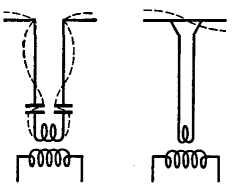| Basic Radio is a free introductory textbook on electronics based on tubes. See the editorial for more information.... |

|

Home  Fundamentals Fundamentals  Radiation Radiation  Transmission Lines Transmission Lines |
||||






|
||||
|
Transmission LinesAuthor: J.B. Hoag In general, the transmitter apparatus cannot be mounted at the same position as the Hertz antenna. The energy is fed from the h.f. oscillator to the antenna by means of a transmission line. This consists of wires so arranged that they radiate as little energy as possible. There are two types, called tuned or resonant, and untuned or non-resonant lines. Examples are shown in Fig. 8 I.
A tuned line may conveniently be thought of as the mid-portion of the antenna folded upon itself in such a manner that the currents in adjacent wires are in opposite phase but are of equal magnitude. Then the radiation from one wire nearly cancels that from the other.
A line of finite length, connected at its output end to a resistance load numerically equal to the characteristic impedance, acts just like a line of infinite length. The wave travels down the line and is all absorbed in the load; none is reflected to set up standing waves; the line is non-resonant.
|
||||
Home  Fundamentals Fundamentals  Radiation Radiation  Transmission Lines Transmission Lines |
||||
Last Update: 2009-11-01


